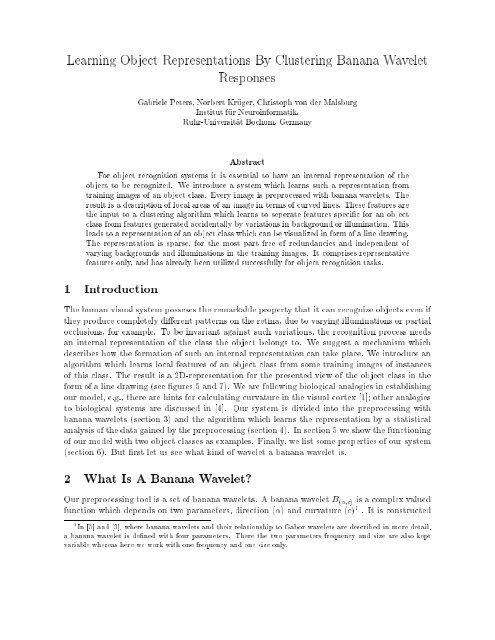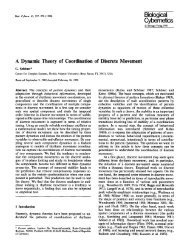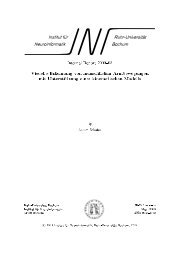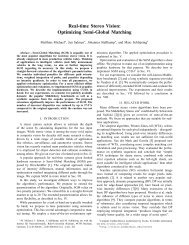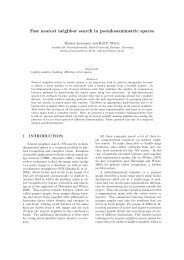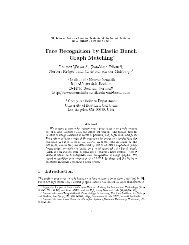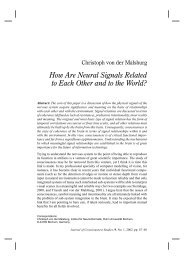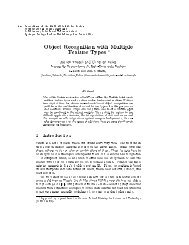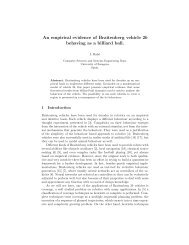1 Introduction 2 What Is A Banana Wavelet? - FIAS
1 Introduction 2 What Is A Banana Wavelet? - FIAS
1 Introduction 2 What Is A Banana Wavelet? - FIAS
You also want an ePaper? Increase the reach of your titles
YUMPU automatically turns print PDFs into web optimized ePapers that Google loves.
Learning Object Representations By Clustering <strong>Banana</strong> <strong>Wavelet</strong><br />
Responses<br />
Gabriele Peters, Norbert Kruger, Christoph von der Malsburg<br />
Institut fur Neuroinformatik,<br />
Ruhr-Universitat Bochum, Germany<br />
Abstract<br />
For object recognition systems it is essential to have aninternal representation of the<br />
object to be recognized. We introduce a system which learns such a representation from<br />
training images of an object class. Every image is preprocessed with banana wavelets. The<br />
result is a description of local areas of an image in terms of curved lines. These features are<br />
the input to a clustering algorithm which learns to seperate features specic for an object<br />
class from features generated accidentally by variations in background or illumination. This<br />
leads to a representation of an object class which can be visualized in form of a line drawing.<br />
The representation is sparse, for the most part free of redundancies and independent of<br />
varying backgrounds and illuminations in the training images. It comprises representative<br />
features only, and has already been utilized successfully for object recognition tasks.<br />
1 <strong>Introduction</strong><br />
The human visual system posseses the remarkable property that it can recognize objects even if<br />
they produce completely dierent patterns on the retina, due to varying illuminations or partial<br />
occlusions, for example. To beinvariant against such variations, the recognition process needs<br />
an internal representation of the class the object belongs to. We suggest a mechanism which<br />
describes how the formation of such aninternal representation can take place. We introduce an<br />
algorithm which learns local features of an object class from some training images of instances<br />
of this class. The result is a 2D-representation for the presented view of the object class in the<br />
form of a line drawing (see gures 5 and 7). We are following biological analogies in establishing<br />
our model, e.g., there are hints for calculating curvature in the visual cortex [1]; other analogies<br />
to biological systems are discussed in [4]. Our system is divided into the preprocessing with<br />
banana wavelets (section 3) and the algorithm which learns the representation by a statistical<br />
analysis of the data gained by the preprocessing (section 4). In section 5 we show the functioning<br />
of our model with two object classes as examples. Finally, we list some properties of our system<br />
(section 6). But rst let us see what kind of wavelet a banana wavelet is.<br />
2 <strong>What</strong> <strong>Is</strong> A <strong>Banana</strong> <strong>Wavelet</strong><br />
Our preprocessing tool is a set of banana wavelets. A banana wavelet B (;c) is a complex valued<br />
function which depends on two parameters, direction () and curvature (c) 1 . It is constructed<br />
1 In [5] and [3], where banana wavelets and their relationship to Gabor wavelets are described in more detail,<br />
a banana wavelet is dened with four parameters. There the two parameters frequency and size are also kept<br />
variable whereas here we work with one frequency and one size only.
=<br />
Figure 1: A banana wavelet is the product of a curved Gaussian and a curved wave function.<br />
Top: Real part of a banana wavelet. Bottom: Real and imaginary part of a banana wavelet<br />
depicted as gray level images with white pixels encoding high values.<br />
_<br />
c = 1 c = 1<br />
_<br />
c = 0 c = - 1<br />
2<br />
2 c = -1<br />
a = 0<br />
a = - p<br />
4<br />
p<br />
a = -<br />
2<br />
a = -<br />
3<br />
4 p<br />
Figure 2: Left: This banana plant consists of four dierent directions and ve dierent curvatures.<br />
Only the real part of each wavelet is shown. Right: The space established by (; c) forms<br />
aMobius topology, here shown for 16 orientations and 3 curvatures.<br />
from a rotated and curved complex wave function and a Gaussian rotated and curved in the<br />
same way (see gure 1). We dene a banana wavelet as follows:<br />
Denition A banana wavelet B (;c) is a mapping B (;c) :IR 2 ! CI<br />
B (;c) (x; y) := exp<br />
0<br />
@, k2<br />
2<br />
0<br />
@<br />
xc<br />
x<br />
2<br />
+<br />
! 11<br />
y<br />
2<br />
c A<br />
y<br />
A exp (i k x c ) (1)<br />
with<br />
!<br />
x c<br />
x<br />
:= C c M <br />
y c y<br />
!!<br />
; M :=<br />
cos sin <br />
, sin cos <br />
!<br />
; C c<br />
x<br />
y<br />
!<br />
:= x , c y2<br />
y<br />
!<br />
;<br />
and ; c; ; k 2 IR.<br />
This means that M carries out a rotation with the angle , and C c performs a curving with<br />
the extent c. k determines the frequency of the wave. The set of Gabor wavelets is a subset of<br />
the set of banana wavelets for Gabor wavelets are characterized by the parameters frequency and<br />
orientation only, i.e., they are uncurved. For our preprocessing we use a set of banana wavelets,<br />
a banana plant (see gure 2). A banana plant can be generated by rotating and curving the<br />
mother wavelet B (0;0) .
3 Preprocessing With <strong>Banana</strong> <strong>Wavelet</strong>s<br />
In every training image we rst manually dene the salient points of an object, e.g., the left<br />
edge of a can or the eyes of a face, so that a landmark in one training image has a corresponding<br />
landmark in every other training image. The surroundings of these landmarks are examined for<br />
curved lines or edges. This is done by abanana transform, i.e., a convolution of a landmark's<br />
surrounding with a banana plant. The response of a banana wavelet B (;c) at a position (x 0 ;y 0 )<br />
in a gray level image I (x; y) is dened by R (;c) (x 0 ;y 0 ):=<br />
<br />
<br />
<br />
I B (;c) (x 0 ;y 0 )<br />
: By performing<br />
a banana transform we receive responses R at every position in a landmark's surrounding for<br />
every banana wavelet of the plant. These responses are arranged in a 4D metric space - the<br />
banana space B - which is established by(x; y; ; c) with (x; y) describing pixels in the landmark's<br />
surrounding and (; c) specifying wavelets of the plant. The metric of B is denoted by d, which<br />
is dened in [5] and is required for clustering.<br />
The banana transform has an important property which we used in our learning algorithm.<br />
Suppose there is a line or an edge with a certain orientation and curvature at some pixel position<br />
in a landmark's surrounding. Then the response R at this position is maximal for that banana<br />
wavelet of the plant whose orientation and curvature corresponds best to the structure in the<br />
training image. The convolution is a measure for the correspondence between a part of the<br />
image and the wavelet. So in the way we use a banana wavelet one can interpret it as a detector<br />
of lines and egdes in images which are oriented and curved in the same way as the wavelet.<br />
4 Learning Important Features Of An Object Class<br />
While reading the single steps of the algorithm, please, refer to gure 3 where every step is<br />
illustrated.<br />
1. <strong>Banana</strong> Transform: Let m be the number of training images, and suppose there are n<br />
landmarks set in each image at salient points of the object. The surrounding of the i-th landmark<br />
of the k-th training image is denoted by Ii k . Now the rst step of our algorithm is to perform<br />
a banana transform with I k i<br />
for i =1;:::;n, k =1;:::;m, i.e., to calculate the values of the<br />
response function R for all images and all landmark surroundings. (This is the preprocessing<br />
described in section 3.)<br />
2. SignicantFeatures Per Instance: From the assumption that a strong response R (;c) (x; y)<br />
means that there is a structure in the image at position (x; y) with orientation and curvature<br />
c we calculate the set Si<br />
Ik of signicant features of the i-th landmark surrounding of the<br />
k-th training image for i =1;:::;n, k =1;:::;m. An element (x; y; ; c) 2Bis dened to be<br />
such a signicant feature, i.e., (x; y; ; c) 2Si<br />
Ik , if it causes a response above a preset threshold<br />
t 1 2 IR + , i.e., R (;c) (x; y) >t 1 , and if the response represents a local maximum in B. A signicant<br />
feature may be specic for the object class, and in this case should be \kept in mind", or<br />
it just may derive from the background or a reex caused by the illumination. In this case it<br />
should be\forgotten" (see gure 4) .<br />
3. Union Over All Training Images: We dene the union S i := S m<br />
k=1<br />
Si<br />
Ik and calculate it<br />
for all landmarks i =1;:::;n.<br />
4. Clustering: With each set S i , i =1;:::;n,we perform a simple clustering to seperate the<br />
important signicant features of a landmark's surrounding (i.e., invariant features deriving from<br />
structures typical for the object class) from unimportant signicant features (i.e., noisy features<br />
deriving from the background, reexes or other variations). We start from the assumption that<br />
the important features are similar in a lot of training images, i.e., they have small distances d
for 1. landmark<br />
for n. landmark<br />
1<br />
2<br />
3<br />
S<br />
1<br />
n<br />
S<br />
4<br />
S 1 S n<br />
5<br />
S Rep<br />
Figure 3: The owchart of the algorithm. The line drawings are illustrations, not results.<br />
S I k<br />
5<br />
Figure 4: Left: The training image I k . Right: The generated signicant features for this image.<br />
The set S Ik<br />
5<br />
for the fth landmark surrounding contains a signicant feature which is specic<br />
for the object class (the left edge of the can) as well as a signicant feature which is cleaned out<br />
by the learning algorithm later on (the pen in the background).<br />
in B. The unimportant features are assumed to occur irregularly and be randomly distributed<br />
in B with larger distances d. Thus, by grouping the elements of S i into clusters we expect a<br />
few large clusters the centroid of which representing an important signicant feature, and many<br />
more rather small clusters representing all the features caused by chance. Clustering the set S i<br />
works as follows (the counter l is initialized to 1):<br />
1. Choose an arbitrary element s 2S i and form a new cluster C l out of it.<br />
2. Add to C l successively all remaining elements ~s 2S i with 9 s 2C l : d (~s; s)
Figure 5: Left: 4 of 60 dierent training images. 11 landmarks are chosen as shown here. Right:<br />
The learned representation for the object class "can". For each learned feature of S Rep a line<br />
with the corresponding orientation and curvature is drawn. Using a SPARC station 20 it takes<br />
about 80 s to learn the representation.<br />
Figure 6: Left: Original training image.<br />
generated by our algorithm.<br />
Right: Signicant features of this individual face,<br />
The partitioning gained by this clustering is unambiguous (for a proof see [5]). Now we dene<br />
that an important cluster is a cluster with the number of its elements exceeding a preset threshold<br />
which depends on the number of elements in S i . The learned representation S i , i =1;:::;n, for<br />
the i-th landmark surrounding of the object class is dened by the centroids of the important<br />
clusters.<br />
5. Learned Representation: The learned representation S Rep for the object class is just the<br />
union of the representation for all landmark surroundings S Rep := S n<br />
i=1<br />
S i :<br />
5 Simulations And Results<br />
We would like to demonstrate the usefulness of our algorithm with two object classes, cans and<br />
frontal faces. We use 128 128 gray level images and a banana plant with 8 orientations and 7<br />
curvatures. The landmark surroundings have a size of 17 17 pixels each. For learning a representation<br />
of a can we use a set of 60 training images with varying backgrounds, illuminations,<br />
and can design and slightly varying elevation angles (see gure 5). To learn the representation<br />
of a frontal face we use 30 training images and choose 31 landmarks per face. For an example<br />
of signicant features of an individual face see gure 6, for the resulting face representation see<br />
gure 7.<br />
6 Conclusion and Outlook<br />
The results show that the representation learned is quite independent ofvarying backgrounds<br />
and reexes or shadows caused by dierent illuminations. Even slight occlusions and rotations<br />
of the objects have only a small inuence on the result. The special predenition of features<br />
we are looking for (curved lines) reduces the dimensionality of the learning problem. Our<br />
representation meets the conditions for a sparse coding which has many advantages such as
Figure 7: Left: 4 of 30 dierent training images. 31 landmarks are chosen for every face as<br />
shown in the leftmost image. Right: This is the learned representation for the object class<br />
"face". There are some redundancies in the area of the eyes and nose. That there is only the<br />
left edge of the nose represented whereas the right is not, may derive from the fact that the<br />
illumination does not vary randomly in the training images. It takes about 180 s on a SPARC<br />
station 20 to learn this representation.<br />
redundancy reduction or speed-up in performance (discussed in [2]). A sparsely coded object<br />
is its representation by a small number of binary features (here the presence or absence of a<br />
curved line) chosen from a large set of features (all curved lines of all localities, orientations,<br />
and curvatures). In comparison to other object recognition systems, e.g., [6], the representation<br />
described here has several desirable properties: it comprises only represetative local features of<br />
the object class, it is nearly free of redundancy, it needs less data storage, and it is learned<br />
from noisy data by a process which seperates important from unimportant local features. A<br />
disadvantage of the system described here lies in the manual positioning of the landmarks.<br />
Ways to tackle this problem are suggested in [3].<br />
A representation similar to the one described here is already used successfully in object recognition<br />
tasks, e.g., the matching of an object in an unknown scene. The small amount of data<br />
the representation consists of enables a fast matching which still can be speeded up by approximating<br />
banana wavelet responses by Gabor wavelet responses. All this is described in detail in<br />
[3].<br />
References<br />
[1] A. Dobbins, S. Zucker, M. S. Cynader, Endstopped neurons in the visual cortex as a<br />
substrate for calculating curvature, Nature, vol. 329, pp. 438-441, 1987.<br />
[2] D. Field, <strong>What</strong> is the Goal of Sensory Coding, Neural Computation, vol. 6, no. 4, pp.<br />
561-601, 1994.<br />
[3] N. Kruger, G. Peters, C. v. d. Malsburg, Object Recognition with a Sparse and Autonomously<br />
Learned Representation Based on <strong>Banana</strong> <strong>Wavelet</strong>s, Technical Report IR-INI<br />
96-11. Institut fur Neuroinformatik, Ruhr-Universitat Bochum, 1996.<br />
[4] N. Kruger, M. Potzsch, G. Peters, Utilizing Principles of cortical Processing for Articial<br />
Object Recognition, submitted for Proceedings of \Information, Theory, and the Brain II".<br />
[5] G. Peters, Lernen lokaler Objektmerkmale mit Bananenwavelets, Technical Report IR-INI<br />
96-09. Institut fur Neuroinformatik, Ruhr-Universitat Bochum, 1996.<br />
[6] L. Wiskott, J.-M. Fellous, N. Kruger, C. v. d. Malsburg, Face Recognition and Gender<br />
Determination, Proceedings of the International Workshop on Automatic Face- and Gesture<br />
recognition, Zurich, 1995.


